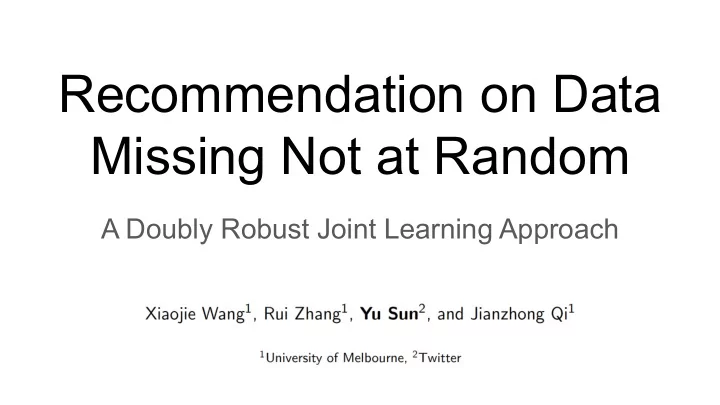

Recommendation on Data Missing Not at Random A Doubly Robust Joint Learning Approach
Rating Matrix Item 1 Item 2 Item 3 ... Item M User 1 4 ... User 2 2 ... User 3 5 ... 5 ... ... ... ... ... ... User N 2 ... 1
Rating Prediction Item 1 Item 2 Item 3 ... Item M User 1 4.5 2.3 3.5 ... 1.8 User 2 6.7 3.9 2.9 ... 3.8 User 3 2.3 4.8 1.1 ... 5.2 ... ... ... ... ... ... User N 2.6 3.5 1.8 ... 0.7
Prediction Error Item 1 Item 2 Item 3 ... Item M User 1 4.5 - 4 = 0.5 ... User 2 2.9 - 2 = 0.9 ... User 3 5 - 4.8 = 0.2 ... 5.2 - 5 = 0.2 ... ... ... ... ... ... User N 2 - 1.8 = 0.2 ... 1 - 0.7 = 0.3
Prediction Error Item 1 Item 2 Item 3 ... Item M User 1 4.5 - 4 = 0.5 2.3 3.5 ... 1.8 User 2 6.7 3.9 2.9 - 2 = 0.9 ... 3.8 User 3 2.3 5 - 4.8 = 0.2 1.1 ... 5.2 - 5 = 0.2 ... ... ... ... ... ... User N 2.6 3.5 2 - 1.8 = 0.2 ... 1 - 0.7 = 0.3
Handling Missing Ratings: Ignore Them Item 1 Item 2 Item 3 ... Item M User 1 0.5 ... User 2 0.9 ... When missing ratings are missing at random ( MAR ), the prediction error is User 3 0.2 ... 0.2 unbiased ... ... ... ... ... ... i.e., User N 0.2 ... 0.3
Missing Ratings: Missing Not at Random ○ Missing ratings: missing not at random ( MNAR ) ○ Rating for an item is missing or not: the user’s rating for that item ○ Producer: ○ Tens of thousands of items, not randomly chosen to present ○ Selection / ranking / filtering process ○ User: ○ Normally don’t choose items randomly to watch/buy/visit ○ After watching/buying/visiting, don’t choose items randomly to rate, either ■ Rate those they have an opinion Can we do better when ratings are MNAR?
Handling Missing Ratings: Error Imputation Item 1 Item 2 Item 3 ... Item M User 1 0.5 2.2 1.0 ... 2.7 User 2 2.2 0.6 0.9 ... 0.7 The imputed errors can be based on User 3 2.2 0.2 3.4 ... 0.2 heuristics. For example, in an existing work [Steck 2010]: ... ... ... ... ... ... User N 1.9 1.0 0.2 ... 0.3 If the imputed errors are accurate, the prediction error is unbiased
Handling Missing Ratings: Inverse Propensity Item 1 Item 2 Item 3 ... Item M User 1 0.5*1.3 ... User 2 0.9*2.7 ... where User 3 0.2*3.4 ... 0.2*1.4 ... ... ... ... ... ... User N 0.2*3.9 ... 0.3*1.2 If the estimated propensities are accurate, the prediction error is unbiased
Weakness ○ Error imputation based (EIB) ○ Hard to accurately estimate the imputed errors ○ it’s almost as hard as predicting the original ratings ○ Inverse propensity scoring (IPS) ○ often suffers from the large variance issue ○ When estimated propensity is very small, it creates a very large value
Handling Missing Ratings: Proposed Doubly Robust where * and is the imputed error * when imputed error is close to the true error Doubly robust : the prediction error is unbiased when ○ either the estimated propensities are accurate ○ or the imputed errors are accurate
Toy Example Prediction error = 10 / 6
Toy Example Estimated error from EIB is 8 / 6
Toy Example Estimated error from IPS is 9.2 / 6
Toy Example Estimated error from DR is 9.92 / 6
Joint Learning ○ Imputed errors are closely related to predicted ratings, e.g., ○ Accuracy of imputed errors changes when predicted ratings change ○ In turn, changed imputed errors affect rating prediction training ○ Joint Learning Rating prediction model minimizes Error imputation model minimizes error estimated by DR estimator the squared deviation
Analysis of DR Estimator Bias Tail bound Generalization bound
Bias of DR Estimator
Tail Bound of DR Estimator
Generalization Bound
Experiments ○ MAE and MSE when test on MAR ratings
Experiments ○ Estimation bias and standard deviation using synthetic data under MSE
Take Away ○ Missing ratings are not always missing at random ○ Accurate estimation of the prediction error on MNAR ratings improves generalization and performance ○ Doubly robust estimator often gives more accurate estimation ○ Joint learning of rating prediction and error imputation achieves further improvements
Poster: Today @ Pacific Ballroom #217 Thanks for your time! Questions?
Appendix
Appendix
Recommend
More recommend